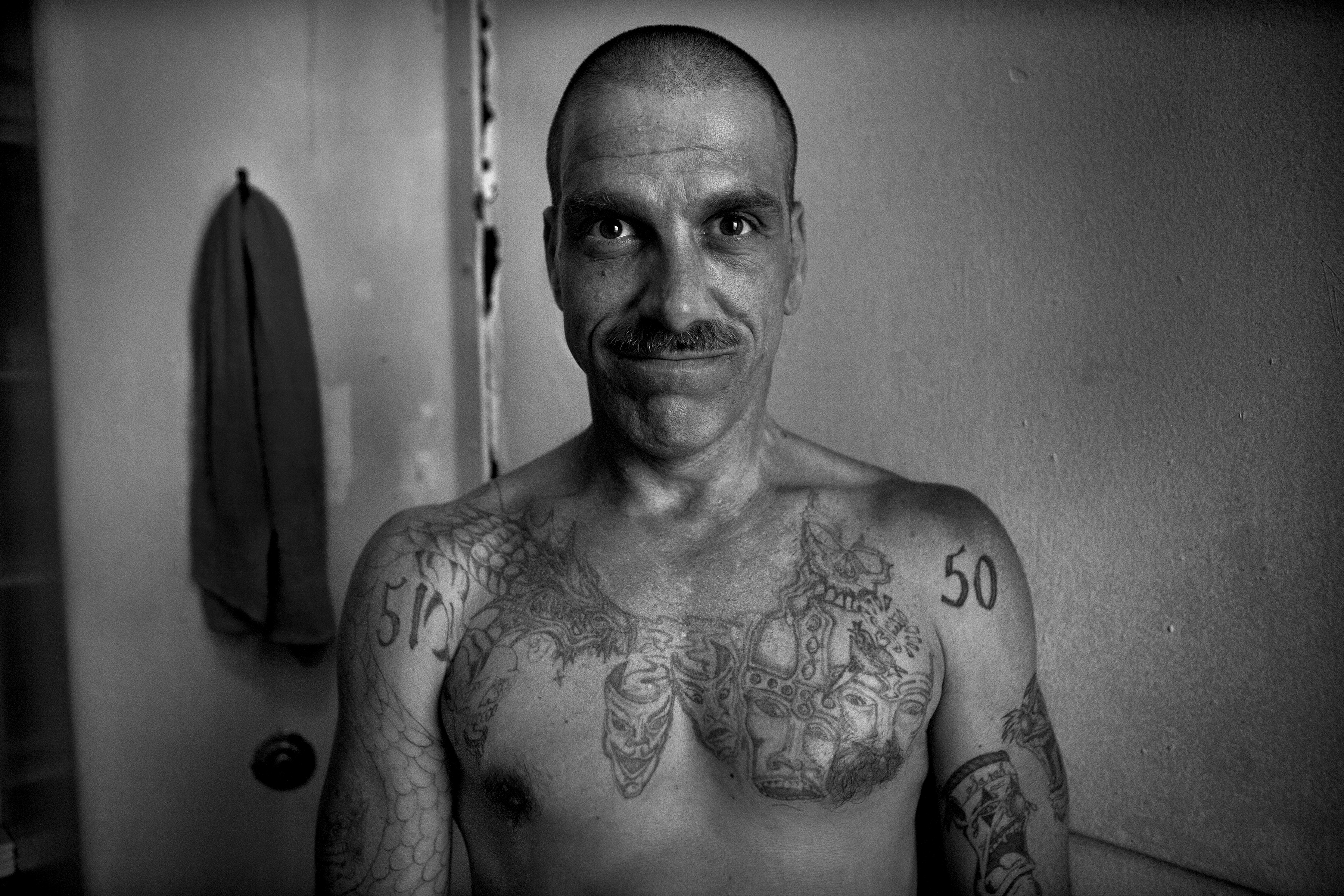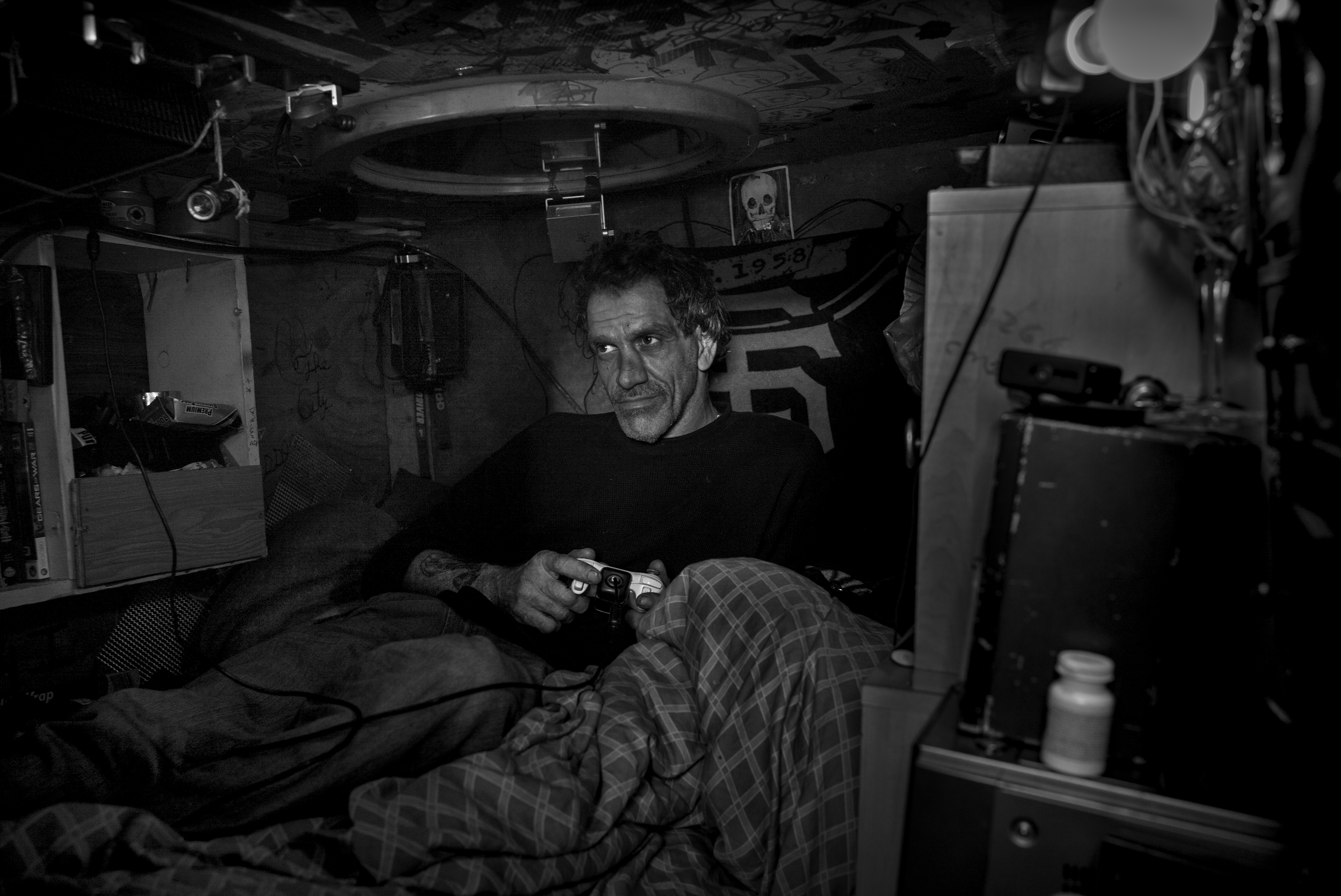December 20th, I was in the Phoenix airport waiting on a flight home to Omaha, when I came across an article announcing the murder of a homeless couple in San Francisco’s Mission District. They were shot and killed near an encampment on the corner of 16th and Shotwell streets. The victims, the paper said, were twenty-seven-year-old Lindsay McCollum and fifty-one-year-old Eddie Tate. I recognized Tate’s name. I had met him while photographing inmates at “Old Bruno,” the oldest of San Francisco’s jail faculties. The jail closed in August of 2006 in part because Tate and six other prisoners filed a lawsuit charging overcrowding and a physical structure showing all of its 70 years, a place not fit to live or work in.

I saw Eddie once more in 2011 when he was locked up in the new SF jail in San Bruno and this time recorded a few of the stories he told me.
A slightly built man with only a trace of an accent, he told me of his life growing up in rural Tennessee: “I was one of them that … lived so far up in the hills of Tennessee that I hardly ever got to go to school, and then when I went to school I was such a pain and everything that I’d make a straight F and they would pass me just to get rid of me. What education I got, I got through the prison system.” Tate moved to San Francisco after the 1989 earthquake, and since that time has gone by the nickname Tennessee. When I met him at Old Bruno, he was using the time in jail to get his high school diploma. Tate had been clean for sixteen months, for the first time in as long as he could remember. He was a hyperactive infant and his dad put alcohol in his bottle to “knock me out, to get me to go to sleep… and I’ve been on some substance or another my entire life.”
As for doing time, Eddie summed up his strategy by saying: “I have to be crazy to live the life that I live. I don’t want no misunderstanding, if you push I will get real crazy on you.” Speaking of the 51-50 (police code for a “danger to self or others”) tattoo on his shoulders: “… so my part of the 51-50 is the ‘or others.’” But Eddie Tate was tired of doing time, he was finished with the drugs and the coming to jail. I did not see him again for several years.
Between 2011 and 2016 I would see Tate now and again while photographing on the streets. Our conversations were never long, but he seemed to have been good to his word and settled into a life outside of incarceration.

In the run up to the February 2016 Super Bowl the City had forced the homeless people encamped in the city’s tourist areas to move to less visible areas. Division Street, a long east-west street of small and medium businesses, became the go-to area, and it was on the corner of Harrison and Division Streets that I saw Eddie again. It had been a couple of years since I had seen him and he was living in a large wooden box with four wheels surrounded by an amazing amount of things, tools, bikes, parts and items of indeterminate use at that moment.
Eddie Tate could fix most things. He had tools and parts and was generous with his time and skills. Tate got by working on bikes, and was proud of the possessions he had acquired, including the wide-screen television on which he played video games.
He was prouder still that he had stayed out of jail for four years—no small accomplishment for a homeless man with his rap sheet.
For most of February, I would stop by to chat. Then, in March, the City moved to clear the Division Street encampments. Tate was one of the last to move, and I lost track of him until October 2016 when we ran into one another, ironically at Division St and Harrison. Without being specific he told me things were looking up. He had just scored some new clothes: a few pairs of pants, a shirt and underwear. I gave him a couple of pairs of socks and asked where he was living. He said that a number of people were living over by the cut-price food outlet about 5 blocks away on 14th and Shotwell. I told him I’d come visit. Somehow I never did.
By December 20th when I read of the murder of Eddie Tate and his partner, he had moved at least once more to 16th Street and Shotwell were they were shot to death at around 8:45 pm on the 19th of December 2016. Eddie Tate was 51 years old. Lindsay McCollum was 27.
Looking through the images of Eddie on the street, I am reminded that he once told me, “I get along with everybody. I’m hyperactive so I’m always a worker somewhere.” As of now, no motive or suspects have been arrested.
They are hardly unique in their deaths of the homeless on San Francisco streets but I “knew” Eddie Tate a little and will miss him just as those that knew Lindsay McCollum will miss her.
This article was first published online at www.harpersbazaar.com. All images courtesy of Robert Gumpert.

